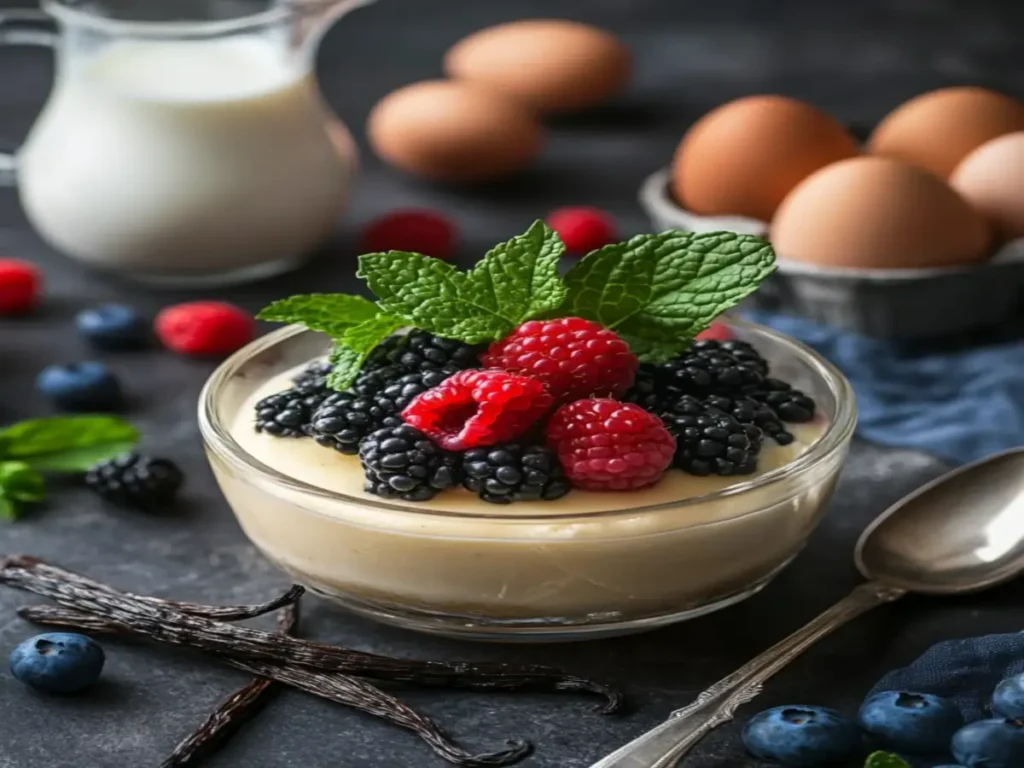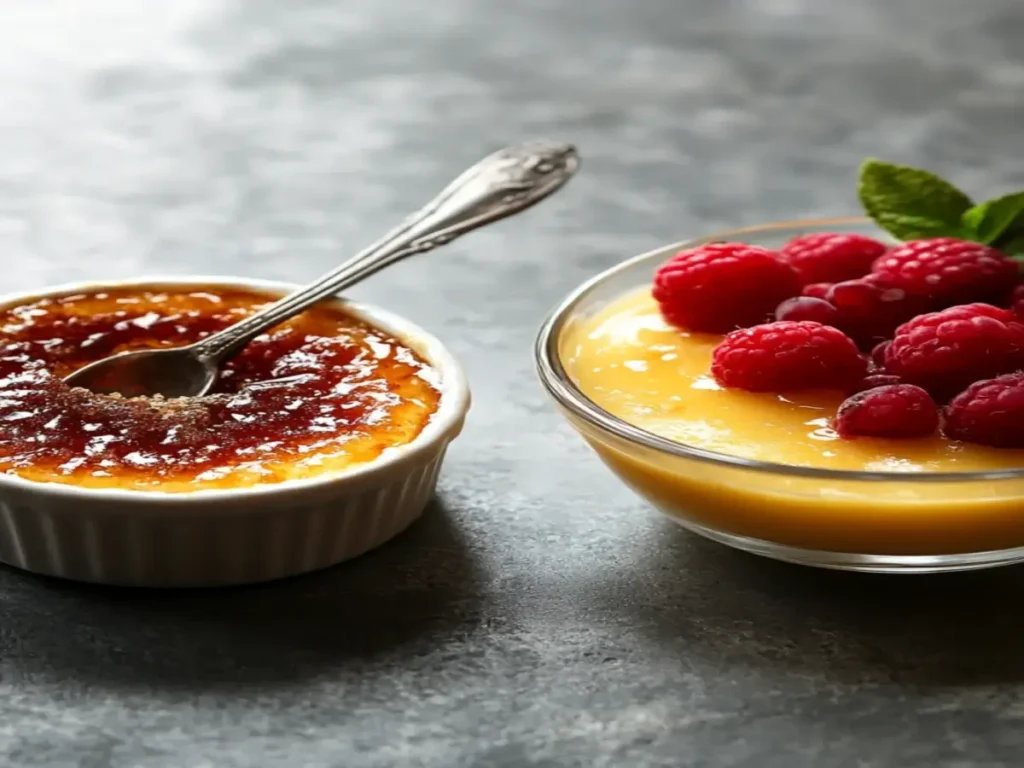Difference Between Crème Brûlée and Custard: Key Distinctions Explained
Crème brûlée and custard are two beloved desserts that share a creamy base, yet they differ in texture, preparation, and presentation. If you’ve ever wondered about the difference between crème brûlée and custard, this guide will break down their unique characteristics.
From the caramelized sugar crust of crème brûlée to the versatile simplicity of custard, understanding these differences will help you choose the right dessert for any occasion. Let’s explore what sets them apart!
Table of contents
What Is Crème Brûlée and How Is It Different from Custard?
Crème brûlée, meaning “burnt cream” in French, is a decadent dessert that has earned its reputation as a sophisticated indulgence. Indeed, its combination of creamy custard and caramelized sugar makes it truly unforgettable. Typically, its silky custard base is baked to perfection and topped with a crackly layer of caramelized sugar. Moreover, the delightful contrast between the smooth custard and the crispy, caramelized top elevates it to the status of a true culinary masterpiece. As a result, crème brûlée has become a symbol of elegance and refinement in the dessert world.
If you’re looking for tips to make the perfect crème brûlée, check out The Secret to Perfect Crème Brûlée.
Where Did Crème Brûlée Originate? A Look at Its History
Crème brûlée has a rich history, tracing its roots back to 17th-century France, although variations have been found in Spain (as crema catalana) and England (as burnt cream). It became popular in French cuisine and eventually gained global recognition for its refined flavor and texture.
How Is Crème Brûlée Made? Step-by-Step Preparation
To prepare crème brûlée, a mixture of cream, egg yolks, sugar, and often vanilla is gently heated and then baked in a water bath. After chilling, sugar is sprinkled on top and caramelized with a kitchen torch or broiler, creating the signature crackling crust.
Key Characteristics
- Texture: Velvety and rich.
- Flavor: Usually vanilla-forward, though other flavors like chocolate, coffee, or citrus can be incorporated.
- Presentation: Typically served in individual ramekins with the caramelized sugar layer.
What Is Custard?

Custard is a versatile dessert that serves as a cornerstone in many cuisines. Unlike crème brûlée, custard is simpler in presentation and does not have a caramelized sugar topping. Instead, it shines with its smooth, creamy texture and adaptability. For instance, it can be served on its own as a comforting dessert, layered in trifles, or used as a filling for pastries like éclairs and tarts. Additionally, custard recipes can range from pourable sauces like crème anglaise to firm, sliceable versions used in pies. Because of its neutral flavor, custard can be customized easily with ingredients such as vanilla, nutmeg, or citrus zest. Therefore, it has become a favorite for chefs and home cooks looking to create a variety of desserts.
The History of Custard: How It Became a Classic Dessert
Custard’s history spans centuries, with roots in Europe where it was originally used as a filling for pastries and pies. Over time, it evolved into a dessert on its own, enjoyed plain or with complementary toppings.
How Custard Is Made: Stovetop vs. Baked Methods
Custard can be prepared in several ways, such as stovetop cooking or baking. It’s often thickened with eggs and gently cooked to avoid curdling. The result is a smooth, creamy consistency that can range from pourable to firm, depending on the recipe.
Key Differences Between Crème Brûlée and Custard
- Texture: Soft and smooth.
- Flavor: Subtle and creamy, with variations like vanilla, nutmeg, or citrus zest.
- Uses: Often used as a base for other desserts, such as trifles, éclairs, and tarts.
What Is the Difference Between Crème Brûlée and Custard?

Despite their similarities, crème brûlée and custard differ in several key ways. Let’s break them down:
| Aspect | Crème Brûlée | Custard |
|---|---|---|
| Top Layer | Caramelized sugar crust | No crust |
| Cooking Method | Baked in a water bath | Can be baked, steamed, or cooked on stovetop |
| Presentation | Served in ramekins with a burnt sugar top | Served plain or as a filling |
| Flavor Profile | Rich and indulgent, often vanilla-forward | Simple, versatile, and adaptable |
| Texture | Creamy with a crunchy top | Smooth and soft |
Key Takeaway
While custard is simple and comforting, crème brûlée is celebrated for its dual texture—a creamy base paired with a crisp, caramelized top. This difference alone makes crème brûlée a more luxurious dessert choice.
Preparation Techniques for Crème Brûlée
The process of making crème brûlée is an art form that requires precision and patience. Let’s look at the step-by-step method:
- Prepare the Custard Base: Heat cream with vanilla (or other flavorings), then whisk it into a mixture of egg yolks and sugar.
- Bake in a Water Bath: Pour the mixture into ramekins and place them in a baking dish filled with hot water. This ensures even cooking and prevents the custard from curdling.
- Cool and refrigerate the ramekins for several hours to set the custard after baking.
- Caramelize the Sugar: Just before serving, sprinkle sugar on top and use a torch or broiler to create the caramelized crust.
For a step-by-step guide to making a creamy and luxurious crème brûlée, visit Perfect Crème Brûlée Recipe: A Creamy, Luxurious Delight.
Tips for Success
- Use fresh, high-quality ingredients for the best flavor.
- Avoid overcooking, as this can result in a grainy texture.
- Ensure the sugar is evenly caramelized to achieve a uniform crust.
Preparation Techniques for Custard
You can make custard using various methods, depending on the desired outcome. Here’s a general guide:
- Mix the Ingredients: Combine milk or cream, eggs, sugar, and flavorings.
- Cook Gently: Heat the mixture on the stovetop over low heat, stirring constantly, or bake it in the oven until it thickens.
- Serve custard warm, chill it, or use it as a component in other desserts as needed.
Common Custard Variations
- Pastry Cream: A thicker version used in éclairs and tarts.
- Crème Anglaise: A pourable custard sauce served with cakes or fruits.
- Flan: A custard dessert with a caramel sauce, often confused with crème brûlée.
Tips for Success
- Cook over low heat to prevent curdling.
- Strain the mixture for a smoother consistency.
- Experiment with different flavor additions like cinnamon or almond extract.
The Textural Appeal of Crème Brûlée
One of the defining features of crème brûlée is its textural contrast. Imagine cracking into a caramelized sugar crust with the back of a spoon. That satisfying crunch gives way to a silky, melt-in-your-mouth custard base. This interplay of textures is what sets crème brûlée apart from other desserts.
The Science Behind the Texture
You achieve the creamy base by carefully tempering eggs with warm cream. This process thickens the proteins in the eggs without curdling, creating a perfectly smooth custard. Meanwhile, you form the crisp sugar crust by caramelizing sugar, where heat breaks down the sugar molecules to create a golden, glass-like layer.
Why Texture Matters
Texture enhances the eating experience by providing contrast. The brittle caramel layer complements the soft custard, creating a multisensory delight that’s hard to resist.
The Versatility of Custard
Custard stands out for its adaptability. Whether served on its own, layered in desserts, or used as a filling, it is a staple in many culinary traditions. From trifles to bread pudding, custard has proven to be a versatile player in the dessert world.
Custard in Classic Desserts
- Trifle: Layers of custard, sponge cake, fruit, and whipped cream make this a show-stopping dessert.
- Tarts: Custard serves as the creamy base for fruit tarts, providing a delicious contrast to the crisp pastry.
- Ice Cream: Custard-based ice cream is richer and creamier due to the inclusion of eggs.
Customizing Custard
Custard comes in many flavors, from plain vanilla to chocolate and even fruity ones. Because its base is so simple, it’s easy to get creative with it. For example, you can add citrus zest for a fresh taste or a little nutmeg or cinnamon for a cozy, warm flavor. This is why custard is loved in kitchens everywhere—it’s versatile and works well with many other desserts.
Crème Brûlée vs. Custard: How Do Their Flavors Compare?
While both desserts share a creamy foundation, their flavor profiles differ significantly. Crème brûlée tends to have a richer, more indulgent taste, while custard offers a lighter, more versatile flavor.
Crème Brûlée’s Richness
The heavy cream used in crème brûlée lends it a luxurious mouthfeel. Combined with the caramelized sugar topping, it delivers a deep, almost toffee-like sweetness.
Custard’s Simplicity
Custard, made with milk or a mix of milk and cream, has a more delicate flavor. Its subtle sweetness makes it a perfect canvas for additional ingredients like spices, fruits, or liqueurs.
Cooking Methods: The Difference Between Crème Brûlée and Custard
The techniques used to prepare crème brûlée and custard are similar but have key differences that influence the final product.
Crème Brûlée’s Precise Technique
- Water Bath Baking: Essential for maintaining a stable cooking temperature and preventing the custard from curdling.
- Caramelizing Sugar: A kitchen torch is the preferred tool for achieving the iconic crust.
Custard’s Flexible Methods
- Stovetop Cooking: Great for making custard sauces or fillings.
- Baking: Ideal for firmer custards like flan or baked puddings.
Why Cooking Temperature Matters for Crème Brûlée and Custard
Both desserts rely on gentle heat to avoid overcooking. A digital thermometer can help ensure the perfect temperature—170–175°F for crème brûlée and slightly higher for custard, depending on the recipe.
How Crème Brûlée and Custard Are Served Differently
Presentation plays a significant role in distinguishing crème brûlée from custard.
Crème Brûlée’s Sophistication
With its golden, glass-like sugar topping, crème brûlée exudes elegance. Furthermore, its presentation in individual ramekins adds a touch of sophistication, making it an ideal choice for special occasions or fine dining experiences. Indeed, the combination of its refined appearance and luxurious taste ensures that crème brûlée always leaves a lasting impression.
Custard’s Humble Appeal
Custard is more understated in its presentation. It can be served in bowls, poured over desserts, or layered in trifles. Its versatility allows it to be both a standalone treat and a supporting player in more elaborate desserts.
Different Types of Crème Brûlée: Unique Flavors & Styles
Crème brûlée is traditionally flavored with vanilla, but chefs worldwide have put their own spin on this classic dessert.
Unique Takes on Crème Brûlée
- Chocolate Crème Brûlée: A decadent twist with rich cocoa flavors.
- Lavender Crème Brûlée: Infused with floral notes for a sophisticated taste.
- Matcha Crème Brûlée: Combines the earthiness of green tea with the dessert’s creamy base.
Seasonal Flavors
Citrus zest, pumpkin spice, or eggnog can transform crème brûlée into a seasonal delight. These variations showcase the dessert’s adaptability while maintaining its signature elegance.
Custard Variations: From Classic to Modern Twists
Custard’s simplicity makes it a blank canvas for endless flavor combinations and uses.
Regional Variations
- Crema Catalana: A Spanish version similar to crème brûlée, but with a lighter custard base.
- English Custard: Often served as a sauce for puddings and cakes.
- Flan: A caramel-topped custard popular in Latin America and the Philippines.
Infusions and Add-Ins
From vanilla beans to unique spices like cardamom, custard can take on many flavors. In addition, swirls of fruit purée or chocolate not only enhance the taste but also add visual appeal. For example, a vibrant berry purée creates a pop of color, while rich chocolate swirls add depth and indulgence. As a result, these additions make custard even more enticing, turning a simple dessert into a visually stunning and flavorful creation.
Nutritional Comparison
While most people don’t associate desserts with health food, crème brûlée and custard do have some nutritional differences.
Crème Brûlée
- Calories: Higher due to the use of heavy cream and sugar topping.
- Fat Content: Rich in saturated fat, making it a treat best enjoyed in moderation.
Custard
- Calories: Typically lower when made with milk instead of cream.
- Protein: Provides a good source of protein from the eggs.
Healthier Options
For a lighter alternative, custard can be made with low-fat milk or dairy-free substitutes. Crème brûlée, however, relies on its richness for flavor and texture, making it harder to modify without compromising its essence.
Pairing Suggestions for Crème Brûlée and Custard
Pairing these desserts with complementary flavors elevates their taste and presentation.
Crème Brûlée
- Wine: A sweet dessert wine like Sauternes or Moscato enhances the caramel notes.
- Fruit: Fresh berries provide a tart contrast to the rich custard.
Custard
- Toppings: Whipped cream, nuts, or caramel sauce add flavor and texture.
- Baked Goods: Serve with cakes, pastries, or biscuits for a complete dessert experience.
Which Should You Choose?
When deciding between crème brûlée and custard, consider the occasion and your personal preferences.
- Crème Brûlée: Ideal for special occasions when you want to impress guests. Its rich flavor and elegant presentation make it a showstopper.
- Custard: Perfect for everyday indulgence or as a component in more complex desserts. Its versatility and simplicity make it a crowd-pleaser.
Conclusion
Crème brûlée and custard are two sides of the same creamy coin, each offering unique experiences. While crème brûlée dazzles with its crunchy caramelized topping and rich base, custard charms with its simplicity and versatility. Both desserts hold a special place in the hearts of dessert lovers, and trying both is the only way to truly appreciate their differences.
FAQs
What Is the Difference Between Crème Brûlée and Custard?
The main difference between crème brûlée and custard is their texture and preparation. Crème brûlée has a crisp caramelized sugar topping, while custard remains smooth and soft. Additionally, crème brûlée is baked in a water bath and finished with a torch, whereas custard can be made on the stovetop or in the oven.
Can You Make Dairy-Free Custard?
Yes! Custard can be made dairy-free by using alternatives like almond milk, coconut milk, or oat milk. However, the difference between crème brûlée and custard in this case is that crème brûlée relies heavily on heavy cream, making dairy-free substitutions trickier.
What’s the Best Sugar for Crème Brûlée’s Caramelized Topping?
The best sugar to use for the crème brûlée topping is granulated sugar, as it caramelizes evenly and creates a perfect crunchy layer. One key difference between crème brûlée and custard is that custard does not have a caramelized sugar topping.
How Long Does Custard Last in the Refrigerator?
Custard can be stored in an airtight container in the refrigerator for 2-3 days. Unlike crème brûlée, which is typically served fresh with a crispy top, custard can be refrigerated and used as a filling for pies, trifles, and other desserts.
Can I Make Crème Brûlée Without a Kitchen Torch?
Yes, if you don’t have a kitchen torch, you can caramelize the sugar topping using the oven broiler. Place the ramekins under the broiler for a few minutes until the sugar melts and forms a crisp crust. This is one major difference between crème brûlée and custard, as custard doesn’t require a caramelized top.
Is Crème Brûlée Naturally Gluten-Free?
Yes! Crème brûlée is naturally gluten-free since it is made with cream, egg yolks, sugar, and vanilla. Similarly, custard is also gluten-free, unless thickened with flour or cornstarch.
